New papers Genomic History of Neolithic to Bronze Age Anatolia, Northern Levant, and Southern Caucasus, by Skourtanioti et al., and (open access) The Genomic History of the Bronze Age Southern Levant, by Agranat-Tamir et al., both in Cell (2020) 181(5).
Interesting excerpts from Skourtanioti et al. (2020) (emphasis mine):
Genetic Continuity in Anatolia
We focused on the three Late Chalcolithic groups with sufficiently large sample size and who are the earliest in time among the LC-LBA groups: ÇamlıbelTarlası_LC (n = 9), İkiztepe_LC (n = 11), and Arslantepe_LC (n = 17). Taking individual estimates from all these individuals together (“Anatolia_LC”), we obtain a robust admixture date estimate of 105 ± 19 generations ago when we use Barcın_N and modern Caucasians as proxies of the source gene pools. Using a generation time of 28 years (Moorjani et al., 2016), this estimate equates to an admixture event ∼3,000 years before the time of the LC-LBA individuals, corresponding to ∼6500 years BCE.
Büyükkaya_EC is the earliest individual in our dataset with a genetic profile similar to the LC-LBA groups within Anatolia. Therefore, we also tested a scenario in which the later LC-LBA groups had descended from the same gene pool without further external contribution. f4(Mbuti,X;Büyükkaya_EC,LC-LBA) suggests that Büyükkaya_EC shares more alleles with the European/Anatolian Farmers (e.g., Boncucklu, LBK, Barcın_N) than LC-LBA groups do. Likewise, most LC-LBA groups cannot be modeled in qpAdm as a sister group with Büyükkaya_EC when Barcın_N is included in the outgroups (p < 0.05 for 1-way model for 11/12).
The time around 6500–6400 years BCE marks a significant junction in the Anatolian Neolithic because it saw a sudden and massive expansion of sedentary communities into areas that had previously supported no or very few food-producing communities before (Brami, 2015, Düring, 2013). Subsequently, in the Southern Caucasus, the abrupt appearance of a Neolithic lifestyle and the introduction of exogenous domesticated animal and plant species ca. 6000 BCE suggests some type of interaction with, and eventually intrusion of Neolithic populations from the neighboring regions, among which Southeastern Anatolia—along with Zagros and the Caspian belt—could be one of the most suitable candidates (Chataigner et al., 2014).
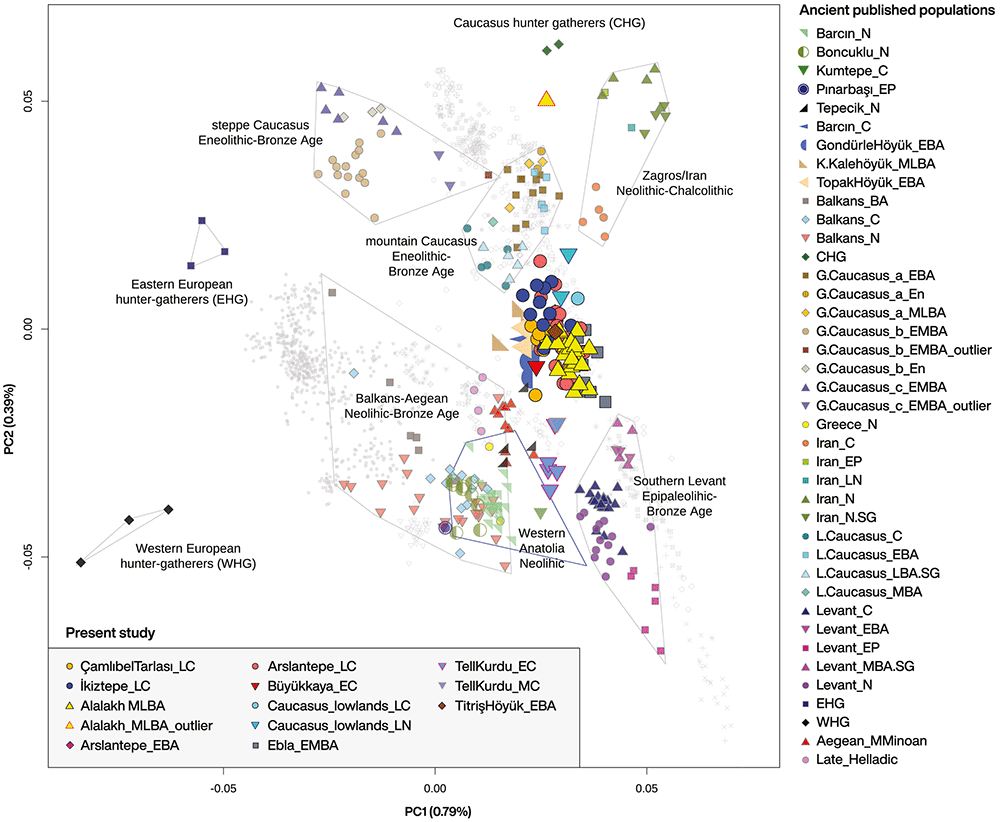
No evidence of gene flow?
In the subsequent millennia and until the Late Bronze Age, genetic continuity persisted in North-Central and Eastern Anatolia, which is supported by the genetic similarity of these later populations and the absence of new ancestry sources after the Neolithic period. This contradicts prior hypotheses for population change based on archaeological evidence of intense cultural interactions during this period. For example, the site of İkiztepe on the Turkish Black Sea Coast contains a material culture with strong Balkan affinities, and this has been argued to signify direct contact with populations across the Black Sea (e.g., Thissen, 1993), but these contacts do not seem to be accompanied by gene flow.
Evidence for genetic homogenization across larger geographic distances also comes from the uniparentally inherited Y chromosome lineages. We observe the most common male lineages J1a, J2a, J2b, and G2a in all spatiotemporal groups of the region. Alongside the less frequent lineages H2 and T1a, these all form part of the genetic legacy that dates to the Neolithic or was already present in the region during the Upper Paleolithic (Wang et al., 2019, Lazaridis et al., 2016, Jones et al., 2015, Feldman et al., 2019, Broushaki et al., 2016).
In the subsequent millennia and until the Late Bronze Age, genetic continuity persisted in North-Central and Eastern Anatolia, which is supported by the genetic similarity of these later populations and the absence of new ancestry sources after the Neolithic period.
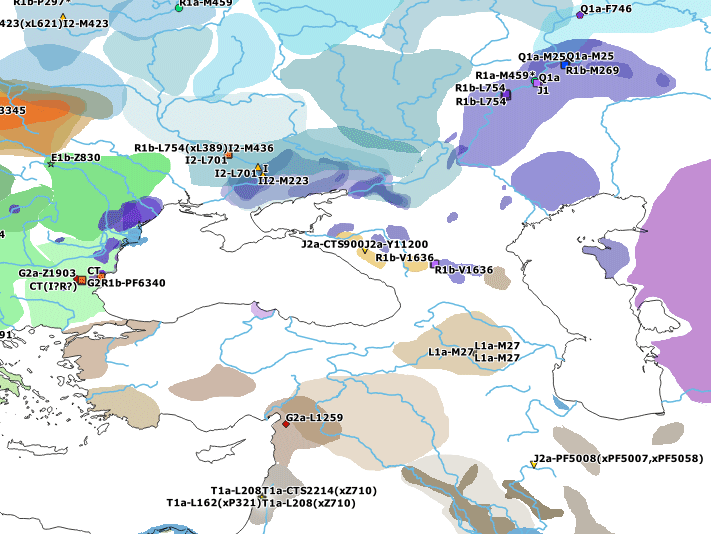
The paper mentions in particular İkiztepe on the Black Sea Coast, which shows a material culture with strong Balkan affinities. This confirms that the available İkiztepe individual from the end-4th millennium BC represented not only the actual community at the time (and was not a recent incomer from the Southern Caucasus), but also that it continued this likely ancestry of Hattic-related North Anatolians homogenized during the previous period, judging by the earliest available sample from the beginning of the millennium.
Arslantepe

Contrasting with the conclusions about İkiztepe based on a handful of samples, the Arslantepe sampling offers two important cues as to the origin of Anatolian languages and the fate of the lineages brought by their speakers:
1. An Arslantepe LC individual, ART038 (ca. 3361-3105 BC), shows hg. R1b-V1636, also highlighted by the paper. The authors, in their outdated comparison to the main haplogroup (R1b-Z2103) reported from Yamnaya and Afanasievo, forget to mention that this same hg. R1b-V1636 was found before in Khvalynsk and in Khvalynsk-related Progress 2, and later in Yamnaya from the Caucasus.
ART038 [S150 (H221)] is a young female [sic] from Period VI B1/VI B2 lying on top of stone slabs closing the Royal tomb. Probably sacrificed. Dating of human bone: 3361-3105 cal BCE (4534 ± 27 BP, MAMS-34112).
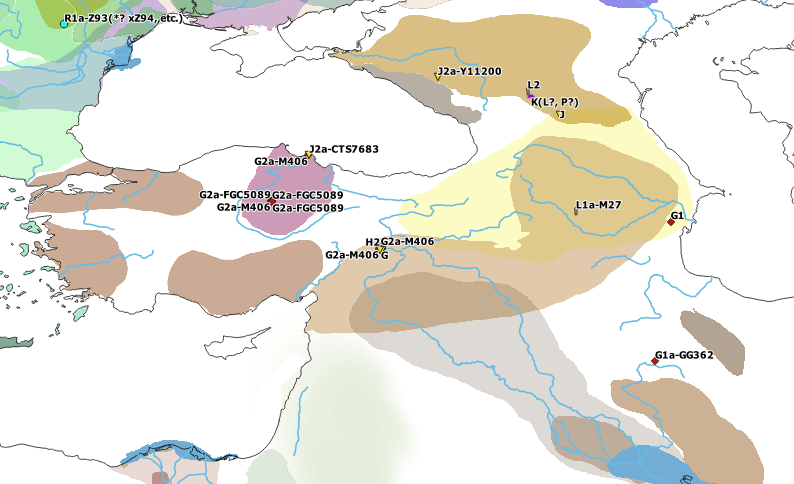
2. The fact that it has no Steppe ancestry shows how gene flows were easily diluted among a demographically dense Near Eastern population within a few generations. The case of the subsequent Arslantepe EBA period, when Kura-Araxes dominated over the site, is illustrative of a similar process:
In PCA and f4-statistics, two individuals dating to this period show excess affinity with populations from the Caucasus and the Pontic steppe compared to their peers, while later Arslantepe_EBA individuals do not share this Caucasian affinity. This implies that the postulated demic interaction must have been transient and of small scale, although the small sample size from Arslantepe_EBA (n = 4) may not be sufficient to detect it. Subtle gene flow is consistent with recent findings from the site, suggesting that the EBA pastoralists occupying the site were more likely well-established local groups moving around the mountains rather than intrusive groups from the Caucasus (Frangipane, 2014).
The only Y-DNA reported from that period is hg. J2a-Z500, which has to be added to the already available Kura-Araxes-related (South Caucasus) G2b-FGC2964, and J1a-Z1842, the three of them thus continuing apparently the previous Near Eastern homogenization period.

You can read more about:
- Ikiztepe and the potential arrival of Proto-Anatolian during the Chalcolithic.
- A discussion of the complex linguistic landscape of Anatolia, including the North Anatolian family (to which Hattic belongs), and Kura-Araxes as the most likely vector of Hurro-Urartian.
- Arslantepe and the likely incursion of Early Anatolians, as well as its conquest by non-Indo-European speakers from Kura-Araxes.
Genetic Turnover in the Bronze Age Northern Levant
The Northern Levant, represented by the sites Tell Kurdu, Ebla, and Alalakh, showcases the most noticeable genetic turnover among our four time transects. Within two millennia after the last Middle Chalcolithic Tell Kurdu individual (TellKurdu_MC), the genetic profile of the populations in and around the Amuq valley (Alalakh_MLBA and Ebla_EMBA) changed to largely resemble contemporaneous Anatolians. However, the qpAdm modeling with Büyükkaya_EC suggests that Alalakh_MLBA and Ebla_EMBA are still distinct from the other Anatolian groups with respect to their connection to the ancient Southern Levant.
All genetic analyses of Alalakh_MLBA were conducted at the exclusion of one female (ALA019) because of her outlier position in the PCA. Discovered at the bottom of a well, the archaeological and anthropological context suggest that the skeletal remains of this woman, C14-dated to 1568–1511 cal BCE (AMS; 2-sigma), represent an irregular burial with evidence of several healed skeletal traumata (…)
In the Eurasian PCA, ALA019 falls genetically closer to Chalcolithic and Bronze Age individuals from ancient Iran and Turan (present-day area of Iran, Turkmenistan, Uzbekistan, and Afghanistan) (Narasimhan et al., 2019). These populations represent a west-east genetic cline with varying proportions of ancestries related to Barcın_N, Iran_N and WSHG (hunter gatherers from Western Siberia). We confirmed the genetic affinity of ALA019 observed in the PCA with an outgroup-f3 test. Other ancient populations from the Caucasus and the Western steppe also produced high affinity but f4(Mbuti, X; Turanx, ALA019) suggest that ALA019 differs from other Turan individuals by occasionally sharing more or less alleles with either Iran_N or WSHG, which agrees with the presence of a genetic cline in this area. In the absence of ancient genomes from nearby regions such as Southern Mesopotamia, the most likely ancestral origin of this individual was somewhere in Eastern Iran or Central Asia.
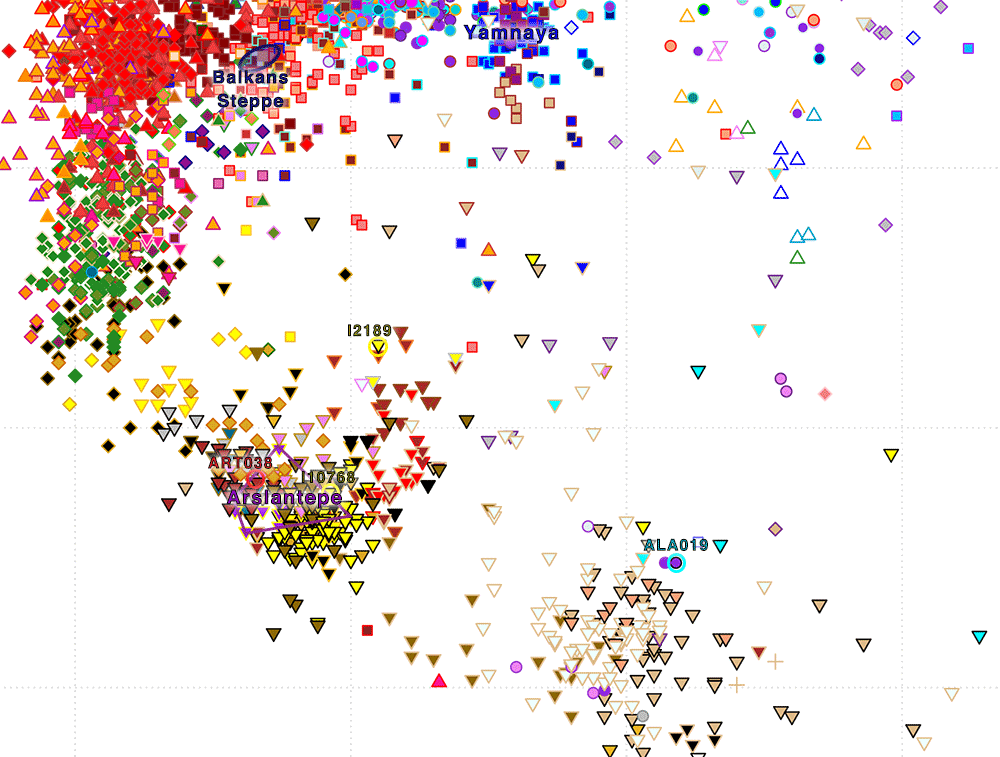
Interestingly, and even though the sample is female, ALA019 displays an ancestry similar to the region where Bronze Age Near Eastern Indo-Aryan speakers are supposed to have expanded from. The presence of multiple injuries (potentially dating to her childhood) indicate a hard life, and her ‘burial’ – for lack of a better name – also implies a hard death, but its difficult to draw any conclusions from a single individual:
ALA019 (Square 32.57, Locus 247, AT 15878) is an adult female aged 40-45 years old (Haas et al., 1994) found at the bottom of a very deep well [hence, dubbed “the Well Lady”; (Shafiq, 2020)]. The remains exhibit presence of osteoarthritis with eburnation (OA) on the cervical vertebrae between C1 and C2 (Waldron, 2001), along with the rare presence of adventitious bursa (Kwong et al., 2011) on lumbar 3 and 4. The individual shows evidence of healed trauma on the frontal bone of the skull (Byers, 2011) and two healed fractured ribs (Shafiq, 2020). Enthesophytes were found on both calcaneal bones (Waldron, 2001). (…) She was discovered facedown with her limbs splayed, indicating that she had been carelessly thrown into the well while it was still in use (probably for domestic/craft purposes or for animals). As this individual’s deposition was the result of misadventure, rather than deliberate burial, there are no accompanying grave goods. Dating of human bone: 1625-1511 BCE (3298 ± 23 BP, MAMS-33687).
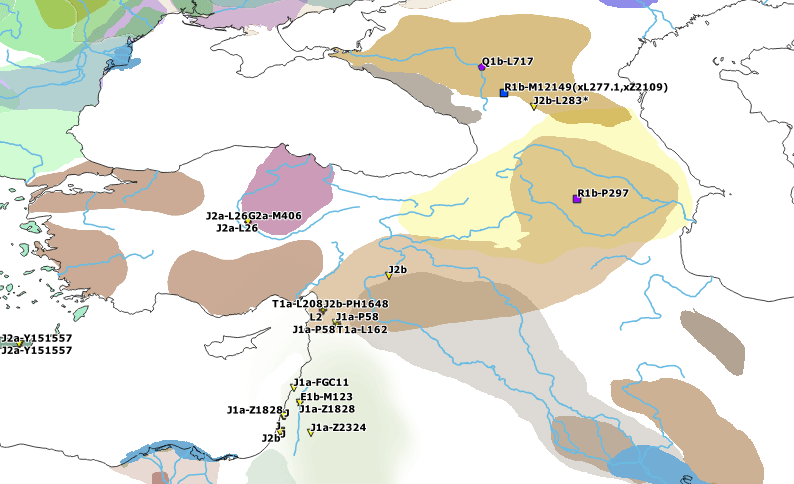
The likely connection of this heavily admixed Turan-like outlier to the arrival of Mitanni Indic suggests, once again, that the expansion of Indo-Iranian languages was a much more complex phenomenon than the Y-DNA bottleneck under R1a-Z93 and Steppe_MLBA visible in Sintashta-Potapovka and continued in the Andronovo horizon. For more on this, see:
- The initial evolution of Indo-Iranians in Turan and contacts with BMAC.
- A recent update on how Yamnaya-related peoples replaced Europeans, but admixed heavily as they spread to Asia.
- The emergence of Indo-Aryan in the Near East and the chronological position of Mitanni Indic.
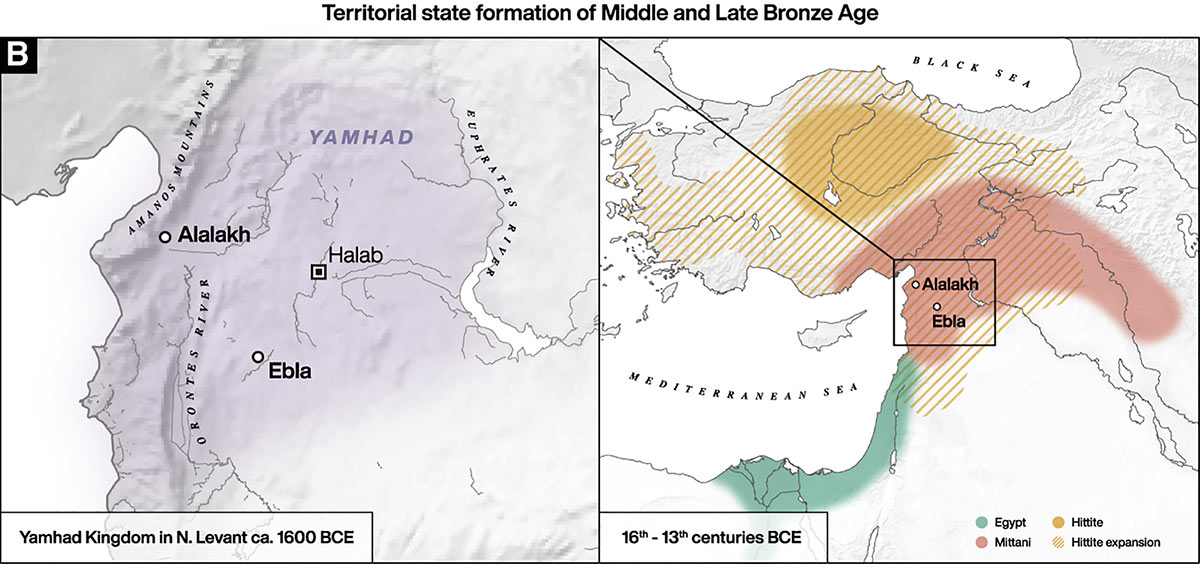
Aegean contacts in Southern Levant MLBA?
Interesting excerpts from Agranat-Tamir et al. (2020):
Earlier genetic analyses modeled the genomes of Middle-to-Late Bronze Age people of the Southern Levant as having almost equal shares of earlier local populations (Levant_N) and populations that are related to the Chalcolithic Zagros (Feldman et al., 2019, Haber et al., 2017, Lazaridis et al., 2016), suggesting a movement from the northeast into the Southern Levant. Here, we provide more details on this process, taking into account evidence from both archaeology and our temporally and geographically diverse genetic data.
The Megiddo outliers, which we inferred to be relative newcomers to the region, are particularly important in demonstrating that the gene flow continued throughout the Bronze Age and that at least some of the gene flow likely came from the Caucasus rather than the Zagros. These two individuals have the highest proportions of Zagros- or Caucasian-related ancestry in our dataset. Analysis of these outliers gave significantly stronger evidence of a Caucasus source compared with a Zagros one, although this conclusion might be revised once ancient DNA data from the Middle-to-Late Bronze Age in the Zagros region become available. The two Megiddo individuals with the next lowest Neolithic Levant component (I10769 and I10770, brothers) were found near the monumental tomb that was likely related to the palace at Megiddo, raising the possibility that they might be associated with the ruling caste. Indeed, a ruler of Taanach (a town located immediately to the south of Megiddo) mentioned in a 15th century BCE cuneiform tablet found at the site and the rulers of Megiddo and Taanach mentioned in the 14th century BCE Amarna letters (found in Egypt) carry Hurrian names (a language spoken in the northeast of the ancient Near East, possibly including the Caucasus) (Na’aman, 1994b). This provides some evidence—albeit so far only suggestive—that at least some of the ruling groups in these (and other) cities might have originated from the northeast of the ancient Near East.

Sample I10768 shows a surprisingly early emergence of hg. R1b-M269 in the Levant (ca. 1600-1500 BC), which may thus be distinct from the Philistine-related samples of Aegean origin, and related to populations from the Zagros Mountains. That connection with expanding non-Indo-Europeans could explain some (R1b-V1636 and R1b-P297, possibly M269) from the 3rd or early 2nd millennium close to the Southern Caucasus.
On the other hand, the most straightforward explanation to this and any other hg. R1b-M269 in the Southern Levant is offered by previous migration events between East Anatolia, the Northern Levant and Zagros, as well as by contemporaneous contacts with the Eastern Mediterranean basin, which could have led to significant genetic inflow probably including the spread of Anatolian and Greek lineages during the early 2nd millennium BC, for example as suggested for Sidon in the same paper.
This could also be valid for the “CHG-related” outlier I2189, if it is of the same haplogroup, against the authors’ suggestion that they are “relative newcomers” from some distant region, despite the lack of a proper sampling from neighbouring Mesopotamia. From Skourtanioti et al. (2020):
Chalcolithic and Bronze Age populations across Anatolia also mostly descended from this genetic gradient. In the Northern Levant, by contrast, we identified a major genetic shift between the Chalcolithic and Bronze Age periods. During this transition, Northern Levantine populations experienced gene flow from new groups harboring ancestries related to both Zagros/Caucasus and the Southern Levant. This suggests a shift in social orientation, perhaps in response to the rise of urban centers in Mesopotamia, which to date remain genetically unsampled.
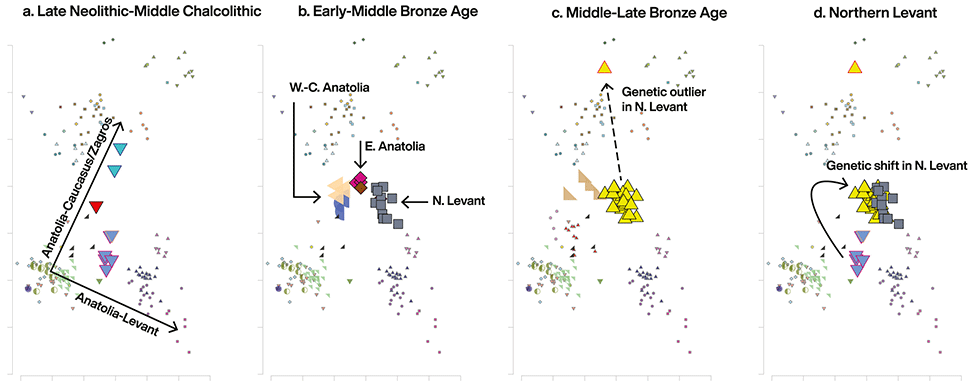
For more on this: